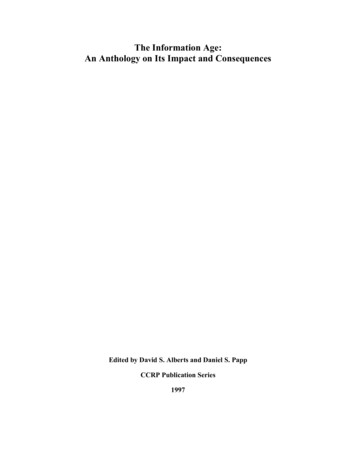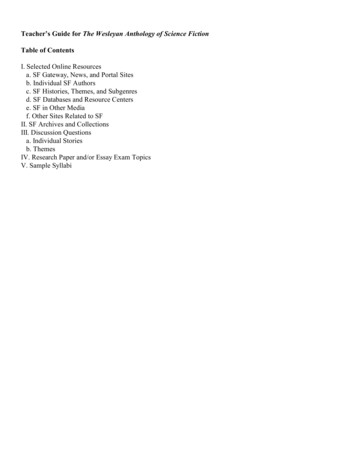
Transcription
The Information Age:An Anthology on Its Impact and ConsequencesEdited by David S. Alberts and Daniel S. PappCCRP Publication Series1997
Table of ContentsAcknowledgments. iPreface: Technology and Change in Human Affairs . iiPart One – The Information and Communication Revolution. 1Introduction. 2Chapter 1: Welcome to the Revolution*. 5Chapter 2: Historical Impacts of Information Technologies: An Overview. 13Chapter 3: The Technologies of the Information Revolution. 36Chapter 4: What Information Society?* . 51Chapter 5: Alone Together: Will Being Wired Set Us Free? * . 72Chapter 6: Reality Check * . 78Part Two: Business, Commerce, and Services. 84Introduction. 85Chapter 7: The Coming Electronic Commerce (R)evolution * . 88Chapter 8: Electronic Commerce: Implications of the Internet for BusinessPractice and Strategy *. 97Chapter 9: Banking and Cyberspace: The New Promised Land *. 107Chapter 10: Silicon Summit: Will Technology Affect the News? ExecutiveSummary * . 113Chapter 11: Medical Informatics * . 122Chapter 12: School Reform in the Information Age *. 132Chapter 13: Universities in the Digital Age *. 145Part Three: Government and the Military. 162Introduction. 163Chapter 14: Telecommunications and Democracy * . 167Chapter 15: Freedom and Censorship in the Emerging Electronic Environment *. 181Chapter 16: Cyberpower * . 191Chapter 17: Congress, Information Technology, and the Use of Force . 197Chapter 18: The Media's Impact on International Affairs, Then and Now * . 206Chapter 19: Warfare in the Information Age *. 217Part Four: International Affairs. 228Introduction. 229
Chapter 20: Telecommunications and the Changing Geographics of KnowledgeTransmission in the Late 20th Century *. 233Chapter 21: Technology, Change, and the Emerging International Order * . 248Chapter 22: Connecting Developing Countries to the Information TechnologyRevolution *. 268Chapter 23: Little Engines That Could: Computing in Small Energetic Countries *278Chapter 24: The Impacts of the Information Age on International Actors and theInternational System . 285About the Authors. 297About the Editors . 300
AcknowledgmentsThis anthology is the product of the ideas and work of many individuals. Lt.Gen. Ervin J.Rokke first suggested the need for this anthology and organized a series of meetings todiscuss potential topics for inclusion in such a volume. David Johnson helped sort andmake sense of the many suggestions received. Alissa Tuyahov and W. Thomas Kemp, IIIspared no effort in searching out the "pearls" from various fields for this volume. Amongthe many individuals who contributed helpful suggestions were Jerry Smith, TomCzerwinski, Gerry Gingrich, Fred Giessler, Dan Kuehl, Jamie Gough, Paul Davis, andDick Hayes. A debt of gratitude is also due to George Maerz and Lydia Candland, whoedited and prepared the final manuscript, and Karina Brazco, who created the covergraphic.i
Preface: Technology and Change in Human Affairsby Daniel S. Papp and David AlbertsWith the fall of communism in Eastern Europe and the dissolution of the Soviet Union,the Cold War ended, and the half-century-old bipolar international system disappeared.These were earthshaking events that rightly received and are receiving extensive studyand analysis. They occurred for a host of reasons, many of which were related to theinternal political, economic, social, and cultural dynamics of communist states. Several ofthe more important reasons were the resentment of citizens of communist states towardthe institutions and individuals that governed them; a resurgence of nationalism withinmultinational states; the inability of communist states to transition successfully fromcentralized political, economic, and administrative structures to more decentralizedstructures; inadequate economic growth rates and declining standards of living; theinability of communist states to diffuse technical advances throughout productive sectorsof society; and over-emphasis on defense spending.1Even as communist states disintegrated from within, another revolution was accelerating.This quieter revolution, still in its infancy, is a scientific and technological one. It’simpact has already been felt, and it promises to change human affairs and theinternational system as extensively as, perhaps even more extensively than, the collapseof the bipolar international system. The revolution in scientific and technological affairshas many dimensions and has led to a debate about whether scientific-technical advancesare changing only the conduct of human affairs and the relationships between present-dayinternational actors, or also the very form and structure of humankind’s institutions andinternational actors themselves.2Throughout history, advances in information and communication technologies, energyand transportation technologies, biotechnology and life sciences, agriculture and industry,weapons technologies, and other scientific-technical fields have played important roles indriving changes in the ways that men and women conduct their affairs. This has been truein virtually every realm of human endeavor including business and banking, industry andmanufacturing, government policy and military affairs, international relations, educationand research, social and cultural relations, political affairs, entertainment and news, andelsewhere.3 Given the magnitude of change that the revolution in science and technologyhas potential to induce, it is vitally important that we understand how this revolution, haschanged, is changing and will continue to change our world.Developing such an understanding is a difficult task. It requires an appreciation andcomprehension of the past and present impacts of science and technology on variousaspects of the human condition, human endeavors, group and organizational dynamics,and on different types of international actors. It also requires an ability to extrapolatefrom this foundation with a willingness to engage in informed speculation about theimpacts that future advances may have and to develop scenarios of how changes inhuman activities and international actors may interact to form a new international system.ii
This book undertakes this task for one major category of scientific and technicaladvances, information and communication technologies. It is based on historical fact,reasoned speculation about future trends in information and communication technologies,and informed analysis about the impacts that those trends might have on human affairsand the international system as we move into the Information Age. This is the firstvolume in a two volume set that will lay the foundation for understanding the ways thatthe Information Age is changing our environment and the institutions upon which wedepend for our liberty, health, and happiness.In this first volume, we will examine some of the broader issues of the Information Age:what the Information Age is; how it affects commerce, business, and service; what itmeans for the government and the military; and how it affects international actors and theinternational system. Not everyone will agree with the viewpoints presented here, but thatis as it should be; the purpose of this volume—and its successor—is more to generatethoughtful debate and discussion than to provide definitive answers. In the secondvolume, we will examine in more detailed terms the meaning of the Information Age forthe U.S. military. It must be stressed, however, that the two volumes go hand-in-hand; theU.S. military is an imbedded system, imbedded in the environment in which it mustoperate.Challenges of the Information AgeComplexity and change are the two defining characteristics of the Information Age. Oursuccesses as individuals, families, organizations, communities, and societies will dependmore than ever upon our abilities to adapt, in near real time, to deal with increasinglycomplex and dynamic situations which will be characteristic of the Information Age.Each of us, individually and institutionally, has developed mechanisms to either shield usfrom or deal with complexity and change. Sometimes these mechanisms work too well.That is, they prevent us from sensing how much our worlds are changing, thus robbing usof an opportunity to understand our environment and appropriately modify old responsesor develop new responses. The results are often catastrophic; we break rather than bend.History is replete with examples of changed environments that were recognized too latefor an institution to successfully adapt. Similarly, history also has many examples ofchanged environments that were recognized, but by institutions or societies that werethemselves unwilling or unable to adapt to new conditions.The Information Age is and will continue to present us with these kinds of challenges atan alarming rate. The increasing complexity of our environment and the actionsnecessary to maintain or improve our equilibrium will only serve to make thesechallenges even more difficult. Successfully responding to these challenges will requirethree things. First, we will need to recognize that something has changed. Second, wewill need to understand the implications of this change. Third, we will need to developtimely and effective responses.In certain segments of society, most of which are associated with business andcommerce, a Darwinian process is at work that rewards the agile and helps ensure thatiii
organizations are responsive to their environments. For this process to work well, oneneeds an active competitive market in which offerings are judged and feedback issupplied continuously. A certain amount of collateral damage is associated with this. Ifthe resulting level of damage is not acceptable, mechanisms are usually put in place tolimit marketplace behavior, which in turn reduces rewards and lowers incentives forchange.This Darwinian option is not suitable for changing the behavior of governmentbureaucracies, especially those entrusted with providing for the common defense. In thiscase, we have an abiding interest in the survival and continuous functioning and readinessof these organizations. We do not want to adopt a strategy that requires failure to achievesuccess.Making our government institutions, and especially those entrusted with providing forour national security, better able to effectively deal with increased complexity and bemore responsive to changes in their environment requires, in some cases, immenseorganizational change. This will not be an easy task, for organizational change willrequire alterations in the very culture of these institutions. In the final analysis, alteringculture means changing behavior, and this demands providing both incentives and tools.While the rigors of the marketplace provide incentives for business firms, firms that havesucceeded have somehow discovered the secret of passing incentives to their employeeswhile providing them with the knowledge and support they need to efficiently turnknowledge into action. Firms whose organizational arrangements and processes distortincentives or fail to empower employees tend to be less successful. Since relatively feworganizations endure, some might argue that success is more the result of the rightorganization with the right product at the right time than the result of an agileorganization that has adapted to changing circumstances.However, the fact is that organizations can adapt if conditions are right. Each of the threenecessary ingredients of success—recognizing a changed situation, understanding itsimplications, and developing a timely and appropriate response— requires anunderstanding, in the case at hand, of the Information Age and how it is affecting peopleand organizations. To reiterate, then, the purpose of this volume is to stimulate thinkingabout how the Information Age is changing our environment so that our national securityinstitutions, in turn, will be able to perform their functions well as the Information Ageprogresses.Assessing the Technology/Society RelationshipAssessing the future impacts of a technology or a group of technologies on even a singlerelatively homogeneous society is a daunting task. Seeking to assess future impacts ofthese technologies on human interactions and institutions and on international actors andthe international system is therefore a task of exponentially greater complexity anddifficulty. This is because there are five major types of international actors (states,multinational corporations, international governmental organizations, non-governmentalorganizations, and individuals) and a large number of sub-national, national, and transiv
national value systems and cultures, each of which may be profoundly affected in termsof theiir capabilities and constraints.Before we attempt this complex task, however, it will be useful to discuss the basicrelationship that underlies this study, the relationship between technology and society.There are three different primary views of this relationship.The first asserts that technology causes change in society, with society having a minimalinfluence on technology. The second reverses the causality of the relationship,maintaining that society and its values drive technology in certain directions and thattechnology is therefore subservient to society and its values. The third argues that therelationship between technology and society is intricate and complex, and that in givensituations and circumstances, either can influence the other to move in a differentdirection. These three relationships are depicted respectively in Figure 1.Emmanuel Mesthene and Langdon Winner are leading proponents of the first view.Mesthene calls his perspective "soft determinism" and maintains that technical advancescreate opportunities to achieve objectives. He asserts that these opportunities forcechange in social organization so that the new technology can be used to pursue the nowattainable objective. This leads to changed functions of existing social structures, whichin turn reduce the ability of old social structures to achieve previous objectives.4Winner further refines this perspective, adding the concepts of "the technologicalimperative," which asserts that technical decisions dominate the structure of modernhuman society, and "reverse adaptation," which argues that the objectives for whichtechnical advances are employed often are relegated to second level priorities, with theprimary priority becoming maintaining the functioning of the technology itself.5 In eitherevent, Mesthene and Winner agree, technology drives social change.Without denying that technology plays an important role in inducing societal change,Lynn White and others reverse the relationship, arguing that society and its values playthe dominant role in determining directions that technologies will takes. For example, ona macro-level, White posits that the emergence of a Judeo-Christian belief and valuestructure in Europe was the dominant factor in permitting and accelerating the emergenceof technologically oriented societies there. White maintains that since Judeo-Christianteachings drew a clear distinction between human beings and nature and argued that onlyhuman beings have spirits, a mind-set developed in Europe that nature was the tool ofhumankind. On a micro-level, White also points out that the values and structures ofdifferent societies often define what is technologically desirable and sometimes evenwhat is technologically permissible, witness the current debate on genetic engineering.Often, effort and funding follow desire and permission.6 Again, however, the keyargument in this second perspective is that society directs technology.A third perspective is that technology plays a significant role in shaping the political,economic, social, and cultural milieu of human society, and that those milieus in turnplay a significant role in shaping technology and how technological advances areemployed by society. Max Weber and E.F. Schumacher are leading proponents of thisv
perspective,7 which has been termed "mutual causality" by other observers who arguethat this view is "not very comforting" because it "displays the full range of the potentialcomplexity of our technological society."8These same observers also maintain that the third perspective is "the safest point fromwhich to view the technology-society interaction" because, unlike the first twoperspectives, it is not a limiting case "where one or the other type of causal influence isdominant."9 Since the editors of this volume believe that this third perspective is the mostaccurate reflection of the present-day relationship between technology and society, thisstudy proceeds from this perspective.What does this mean for the impact of information and communication technologies onhumankind’s activities and institutions and on international affairs? A brief historicalperspective may provide insight.Twice in the twentieth century, the collapse of an international system has coincided withthe coming of age of significant new technologies. Both times, the emerging technologiesplayed a significant role in shaping and molding the new international system. We arewitnessing the third time this century that such a phenomenon has unfolded.10The first time this phenomenon occurred was during World War I, when for the first timethe internal combustion engine was widely used in warfare. Trucks, planes, and tanksplayed major roles in the "War to End All Wars," which both brought to an end the oldEuropean balance of power system and moved much of the world into an era of"collective security." Throughout the interwar period, even though the collective securitysystem codified in the League of Nations proved unable to assure the peace,transportation systems powered by the internal combustion engine helped make the worlda smaller and more intimate place than it had ever been before.Similarly, World War II, the most violent and destructive war in human history, endedwith the use of the most destructive weapon ever used in warfare, the atomic bomb. Notcoincidentally, nuclear weapons and nuclear technologies played a major role instructuring and shaping the post World War II bipolar system and the uneasy equilibriumbased upon mutual assured destruction.In the present time, a new set of advanced information and communication technologiesbegan to emerge even as the old international system weakened. Indeed, some analystsargue that the new technologies contributed directly to the bipolar system’s eventualcollapse, as will be seen later in this volume. But regardless of the accuracy of theseclaims, it is evident that new advanced information and communication technologies willhave a significant impact in shaping and molding humankind’s activities and institutions.They undoubtedly will have an impact on the structure and activities of internationalactors and the emerging international system as well.vi
Conceptual Overview of the VolumeWhat will those impacts be? It is the purpose of this book to help answer that question. Itapproaches the question in a straightforward manner.Part One, "The Information and Communication Revolution," sets the stage. It firstargues that three modern information and communication revolutions have occurredduring the last century and a half, and presents an overview of the historical impacts thatthe information and communication technologies developed during the first tworevolutions have had on humankind’s activities and institutions, and on internationalaffairs and on the international system. It next identifies and analyzes several of the moreimportant information and communication technologies that are part of the presentinformation and communication revolution. Then, it provides different views on thedebate about whether the changes that are occurring and may be expected to occur aresignificant enough to be deemed a revolution. It also presents several cautionary notesabout issues that are arising out of the Information Age.Parts Two and Three, "Business, Commerce, and Services," and "Government and theMilitary," examine the impacts that the technologies of the third modern information andcommunication revolution are having and are likely to have on specific areas of humaninteractions. Areas of inquiry include the impact of new information and communicationtechnologies on business, commerce, services, the government, and the military. Theobjective of Parts Two and Three is to assess the impacts that the technological advancesidentified in Part One are having and are likely to have on specific areas of humaninteraction over the next twenty years.In Part Four, "International Affairs," projections are developed about the ways that theinformation and communication technologies identified earlier are being and might beassimilated and diffused by different state and non-state actors. Part Four also presentsviews about the ways in which international actors and the international system arechanging and may most likely change as a result of advances in information andcommunication technologies.For the convenience of the reader, Parts One through Four are published in four separatevolumes, which are not to be confused with the forthcoming Volume II of the overallanthology.This anthology does not attempt to present an exhaustive analysis of present and potentialimpacts of the ongoing information and communication revolution. Rather, it seeks todiscuss the more prominent impacts, thereby helping readers think beyond the conceptualboxes formed by present-day limitations of information and communication technologies.Notes1. For discussions of what led to the collapse of the Soviet Union, see for exampleStephen White et al., The Politics of Transition: Shaping a Post-Soviet Future (Newvii
York, NY: Cambridge University Press, 1993); and Walter Laqueur, The Dream ThatFailed: Reflections on the Soviet Union (New York: Oxford University Press, 1994).2. See James N. Rosenau, Turbulence in World Politics: A Theory of Change andContinuity (Princeton: Princeton University Press, 1990), which argues that technology isa primary driving force behind a fundamental transformation in the international systemthat has occurred; Eugene B. Skolnikoff, The Elusive Transformation: Science,Technology, and the Evolution of International Politics (Princeton, NJ: PrincetonUniversity Press), which asserts that technology is a driving force behind change, but nofundamental change has occurred in the international system; and Dennis Pirages, GlobalTechnopolitics: The International Politics of Technology and Resources (Pacific Grove,CA: Brooks-Cole, 1989), which posits that the world is entering a third era oftechnology-driven international change, the first two of which were the agricultural andindustrial revolutions. However, Pirages argues the dimensions of the third are not yetclear.3. See for example Paul Kennedy, The Rise and Fall of the Great Powers: EconomicChange and Military Conflict from 1500 to 2000 (New York: Random House, 1987);Lewis Mumford, Technics and Civilization (New York, NY: Harcourt, Brace, 1934); andEugene B. Skolnikoff, Science, Technology, and American Foreign Policy (Cambridge,MA: MIT Press, 1967), as well as the three books listed in Note 2.4. Emmanuel G. Mesthene, "How Technology Will Shape the Future," Science (July 12,1968), pp. 135-143.5. Langdon Winner, Autonomous Technology (Cambridge, MA: MIT Press, 1977),passim.6. Lynn White, Jr., Medieval Technology and Social Change (New York, NY: OxfordUniversity Press, 1966), passim. See also Willis Harman, An Incomplete Guide to theFuture (San Francisco, CA: San Francisco Book Company, 1976), which argues that thevalues and beliefs that underlie industrial society are eroding, and that this will have asignificant impact on future technological directions.7. See for example Max Weber; and E.F. Schumacher, Small Is Beautiful: Economics AsIf People Mattered (New York, NY: Harper Torchbooks, 1973), passim.8. Alan L. Porter, et. al., A Guidebook for Technology Assessment and Impact Analysis(New York, NY: North Holland, 1980), p. 23.9. Ibid.10. In the first two cases, the new technologies did not cause the collapse of the precedingsystem. In the third case, as will be seen later in this volume, it is possible to argue thatthe new technologies contributed to the collapse of the preceding international system.viii
Part One – The Information and Communication Revolution1
IntroductionThe Information Age. That is what many pundits, writers, and analysts have alreadylabeled these concluding years of the twentieth century and the beginning of the twentyfirst century. This characterization of our time is based on the widespread proliferation ofemerging information and communication technologies and the capabilities that thosetechnologies provide and will provide humankind to overcome the barriers imposed oncommunications by time, distance, and location and the limits and constraints inherent inhuman capacities to process information and make decisions. Advocates of the concept ofthe Information Age maintain that we have embarked on a journey in which informationand communications will become the dominant forces in defining and shaping humanactions, interactions, activities, and institutions.They may be right. But often, promoters of the Information Age give little attention tosignificant issues and concerns that arise out of their favorite concept. Is the InformationAge truly already upon us? Just what is meant by the Information Age? How does theinformation and communication revolution fit within the broader sweep of humanhistory, or is it indeed such a significant departure for humankind that past history haslittle relevance? What are the technologies of the information and communicationrevolution? What do they do and what will they do? Is it really a revolution, and are wereally entering an Information Age? Will the capabilities of emerging information andcommunication technologies lead to greater connectivity and commonality of perception,or will they result in greater isolation and fragmentation? These are some of the majorissues explored in Part One of this anthology, designed to set the stage for laterdiscussion and analysis.In the first article, "Welcome to the Revolution," Thomas A. Stewart begins by statingthat the word "revolution" should not be used cheaply. Nevertheless, Stewart asserts, weare in fact already in the midst of a revolution induced by emerging information andcommunication technologies. Concentrating on the impacts that those technologies arehaving in the business world, Stewart explains how knowledge technol-ogies are alteringthe cost/benefit equation for competing organizational arrangements. He concludes thatthe Information Age is placing a premium on "the ability to adjust and learn" that appliesboth to individuals and organizations.Daniel S. Papp, David S. Alberts, and Alissa Tuyahov next place the present informationand communication revolution in historical perspective in their article, "HistoricalImpacts of Information Technologies: An Overview." The authors argue that twoinformation and communication revolutions have already occurred during the last centuryand a half, and that we are now in the beginning phases of a third. They examine thedevelopment of several of the more critical technologies of the first two revolutions, andpresent an overview of the historical impacts that those technologies have had onhumankind’s activities and institutions, and on international affairs and on theinternational
i Acknowledgments This anthology is the product of the ideas and work of many individuals. Lt.Gen. Ervin J. Rokke first suggested the need for this anthology and organized a series of meetings to










